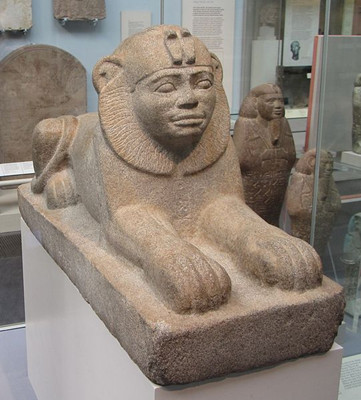Egypt had become fragmented and weak, and the Kushite king, Piankhi, took the opportunity to send his armies north, and capture the cities of Egypt one by one, until finally the north was quashed, and the Kushites were in charge of an empire that ran roughly from modern Khartoum to modern Alexandria.
埃及变得孱弱,王国分崩离析。库施王皮安基抓住机会,调动军队北征,逐一征服埃及各个城池,直至推翻整个埃及王国。库施当时统辖的领地从现代的喀土穆一直延伸到亚历山大。
And in order to govern this new state, they created a new national identity, a hybrid that would combine both Egypt and Kush.
为了统治这个全新的国家,他们创造了一种新的国家认同,将埃及与库施结合了起来。
Taharqo, represented in the British Museum sphinx, is the most important of all the Kushite kings.
大英博物馆的狮身人面像所表现的塔哈尔卡王,是历任库施国王中最重要的一位。
He initiated a golden age for his immense new kingdom, and he succeeded largely because, rather than imposing Kushite customs on the Egyptians, he absorbed and adopted theirs.
他开启了这一庞大新王国的黄金时期。而他成功的主要原因在于,他并没有强迫埃及人接受库施习俗,而是将二者融合起来。
Even in Kush itself, Taharqo built pyramids on the Egyptian model, and he worshipped the Egyptian god Amun; he restored temples in the Egyptian style, and his officials wrote in Egyptian hieroglyphics.
即使在库施本土,他也按埃及模式修建了金字塔。他敬拜埃及的阿蒙神,按照埃及风格重修神庙,并使用埃及象形文字作为官方记录语言。
It's a pattern that we see again and again in successful conquests.
在历史上成功的征服案例中我们能一再看到这种模式:
They used the existing symbols and vocabulary of power, because those are the ones that are already familiar to the population.
征服者沿用原有的权力系统与王权象征,因为它们已为大众熟知。
It makes sense to keep using a language of control that everybody is accustomed to accept.
用百姓们已经接受了的方法来统治他们,可以说是明智之举。
The Sphinx of Taharqo, in its calculated mixture of the two different traditions, is not just a striking portrait of the Kushite ruler as a traditional Egyptian pharaoh, it's also a lesson in political method.
塔哈尔卡的狮身人面像有意把两种不同的文明结合起来,这不只创造出了一尊库施统治者化身为传统埃及法老的动人肖像,也成为政治学的一种经典手段。
And for a short period, that method worked brilliantly.
从短期来看,这种手段成效惊人。













